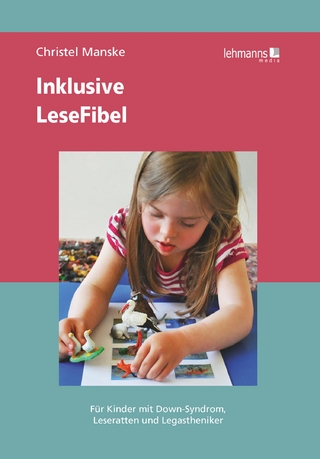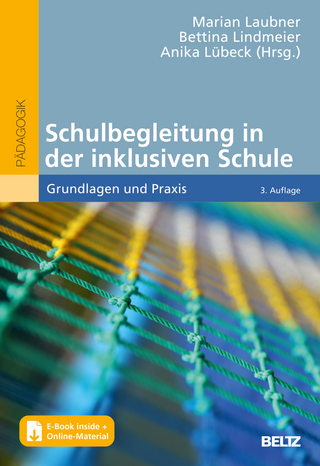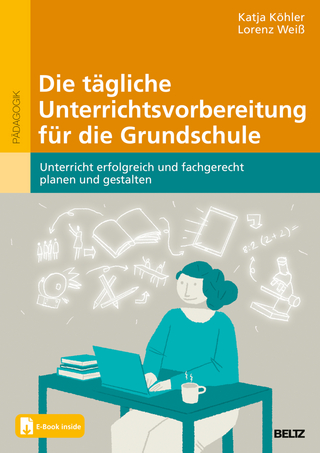
Hands-On Science and Technology for Ontario, Grade 4
Portage & Main Press (Verlag)
978-1-77492-069-5 (ISBN)
- Titel nicht im Sortiment
- Artikel merken
Hands-On Science and Technology for Ontario, Grade 4 is an easy-to-use resource for teaching the five strands of the Ontario science and technology (2022) curriculum:
STEM Skills and Connections
Life Systems: Habitats and Communities
Matter and Energy: Light and Sound
Structures and Mechanisms: Pulleys and Gears
Earth and Space Systems: Rocks and Minerals
Hands-On Science and Technology for Ontario, Grade 4 encourages students’ natural curiosity about science and the world around them as they participate in hands-on activities and explore their environment. Using the inquiry approach, this comprehensive resource
fosters students’ understanding of STEM (science, technology, engineering, and mathematics) skills
makes coding and emerging technologies approachable for both teachers and students
emphasizes personalized learning using a four-part instructional process: activate, action, consolidate and debrief, enhance
relates science and technology to sustainability and our changing world, including society, the economy, and the environment
focuses on practical applications of the engineering design process as students work on solutions to real-life problems
builds understanding of Indigenous knowledge and perspectives specific to Ontario
explores contributions to science and technology by people with diverse lived experiences
Using proven Hands-On features, this book provides resources for both teachers and students including background information on the science topics; complete, easy-to-follow lesson plans; materials lists; and digital image banks and reproducibles (find download instructions in the Appendix of the book).
Innovative elements developed specifically for the Ontario curriculum include the following:
plugged and unplugged coding activities in nearly every lesson
land-based learning activities
opportunities for students to use guided research, hands-on inquiry, and the engineering design process
a fully developed assessment plan to guide assessment for, as, and of learning
ideas and prompts for STEM Makerspace projects
Jennifer E. Lawson, PhD, is the creator of the Hands-On books published by Portage & Main Press. As senior writer and editor for the series, she has contributed to more than 50 publications for teachers and students. Jennifer provides professional development workshops for educators locally, nationally, and virtually, and is a Workplace Wellness Advisor. Her most recent book is a collective effort called Teacher, Take Care: A Guide to Well-Being and Workplace Wellness for Educators. She is also one of the founders of Mission to Mexico, an organization that supports schools in some of the most impoverished communities in Puerto Vallarta. Throughout her extensive career in education, Jennifer has worked as a classroom teacher, resource and special education teacher, consultant, principal, university instructor, and school trustee. She lives with her family in Winnipeg, Manitoba. For over 20 years, Kellie Ierullo (she, her, hers) has been an educator with the Toronto District School Board including as a classroom teacher, special education teacher, and now as a teacher-librarian, technology chair and science/STEM lead educator. Kellie is passionate about helping teachers engage students through meaningful coding and STEM activities and encouraging students to move beyond navigating technology to creating it for themselves. Kellie lives in Woodbridge, Ontario with her family. Jennifer H. Manitowabi (she/her/hers) is an Ojibway educator and PhD student at Lakehead University. Throughout her career in education in both Canada and the US, she has worked as a bus driver, classroom teacher, principal, and education director. Jennifer encourages all teachers to incorporate Indigenous worldviews into their lessons and find opportunities to build relationships with the First Nations of Turtle Island. Jennifer is a member of Lac Seul First Nation, where she currently resides, and can often be found creating artwork that celebrates her culture.
Introduction to Hands-On Science and Technology for Ontario, Grade 4
Introduction to Hands-On Science and Technology 2
Program Introduction 2
The Inquiry Approach to Science and Technology 2
21st Century Teaching and Learning 3
The Goals of the Science and Technology Program 3
Hands-On Science and Technology Strands and Expectations 4
Hands-On Science and Technology Fundamental Concepts and Big Ideas 4
Hands-On Science and Technology Program Principles 4
Infusing Indigenous Perspectives 5
Cultural Connections 6
Land-Based Learning 7
Technology 7
Sustainability 7
Program Implementation 7
Program Resources 7
Classroom Environment 11
Planning Units--Timelines 11
Classroom Management 11
Classroom Safety 12
Scientific Inquiry Skills: Guidelines for Teachers 12
Observing 12
Questioning 12
Exploring 12
Classifying 13
Measuring 13
Communicating, Analyzing, and Interpreting 13
Predicting 15
Inferring 15
Inquiry Through Investigation and Experiments 16
Inquiry Through Research 16
Online Considerations 17
Addressing Students' Literacy Needs 17
Technological Problem Solving 17
Makerspace 18
The Hands-On Science and Technology Assessment Plan 20
Assessment for Learning 21
Assessment as Learning 21
Assessment of Learning 22
Performance Assessment 23
Portfolios 23
Evidence of Student Achievement Levels for Evaluation 24
Important Note to Teachers 24
References 25
Assessment Reproducibles 26
Achievement Chart for Science & Technology 41
Unit 1: Habitats and Communities 43
Introduction 44
Unit Overview 48
Curriculum Correlation 49
Resources for Students 51
1 What Do We Know About Habitats and Communities? 55
2 Why Do Plants and Animals Live in Certain Habitats? 63
3 Which Organisms Are Found in Our Local Habitats? 68
4 How Can We Measure Populations in a Habitat? 74
5 How Do Plants and Animals Adapt to Survive in Their Environment? 79
6 What Relationships Occur Between Populations Within a Community? 86
7 What Are the Characteristics of Herbivores, Carnivores, and Omnivores? 91
8 What Are the Relationships Between Predators, Prey, and Scavengers? 96
9 What Are the Characteristics of Producers, Consumers, and Decomposers? 100
10 What Is a Food Chain? 106
11 What Is a Food Web? 111
12 How Are Plants and Animals Important to Humans and to the Environment? 115
13 How Can We Create Living Habitats? 120
14 What Are Some Natural and Human Impacts on Organisms in the Environment? 123
15 Inquiry Project: What Can I Do to Protect Habitats and Communities? 128
Unit 2: Pulleys and Gears 133
Introduction 134
Unit Overview 138
Curriculum Correlation 139
Resources for Students 140
1 What Do We Know About Forces and Machines? 143
2 How Do Wheels and Axles Work? 148
3 How Do Gears Help Make Work Easier? 154
4 What Can We Learn About Gears and Direction of Movement? 159
5 How Can We Design and Construct Devices With Working Gears? 165
6 How Does a Single-Fixed Pulley Make Work Easier? 168
7 How Do Movable and Compound Pulleys Make Work Easier? 173
8 How Can We Design and Construct a Working Pulley System? 180
9 What Are the Advantages and Disadvantages of Using Machines With Pulleys and Gears? 184
10 Inquiry Project: How Can We Design and Build a System of Pulleys and Gears for a Specific Purpose? 188
Unit 3: Light and Sound 191
Introduction 192
Unit Overview 197
Curriculum Correlation 198
Resources for Students 199
1 What Do We Know About Light? 203
2 How Does Light Travel? 208
3 How Does Light Reflect? 213
4 How Well Does Light Pass Through Different Materials? 218
5 How Can We See Light’ s Many Colours? 222
6 How Has Light Technology Changed Over Time? 226
7 Inquiry Project: How Can I Design and Construct an Optical Device to Transmit and Reflect Light? 230
8 What Do We Want to Learn About Sound? 234
9 How Is Sound Created? 239
10 What Is Pitch? 244
11 How Do Sound Waves Travel? 249
12 Which Materials Are Insulators or Conductors of Sound? 253
13 How Can We Amplify Sound? 257
14 How Do We Hear Sound, and How Can We Protect Our Sense of Hearing? 261
15 How Do Musical Instruments Use Sound Energy? 267
16 How Can We Design and Construct Musical Instruments Using Various Materials? 272
17 Inquiry Project: What Can We Learn About Sound Technology? 278
Unit 4: Rocks and Minerals 281
Introduction 282
Unit Overview 285
Curriculum Correlation 286
Resources for Students 287
1 What Do We Know About Rocks and Minerals? 289
2 How Can We Compare and Classify Rocks and Minerals? 295
3 How Can Minerals Be Classified? 299
4 How Are Different Types of Rock Formed? 304
5 What Are Some Uses for Rocks and Minerals? 313
6 How Are Fossils Formed? 319
7 Inquiry Project: How Are Rocks and Minerals Mined From the Earth? 324
8 How Does Mining Impact Habitats and Communities? 327
References 332
Appendix: Image Banks 333
About the Contributors 342
| Erscheint lt. Verlag | 26.2.2025 |
|---|---|
| Co-Autor | Kellie Ierullo, Jennifer Manitowabi |
| Zusatzinfo | Illustrations, unspecified |
| Sprache | englisch |
| Maße | 215 x 279 mm |
| Gewicht | 857 g |
| Themenwelt | Schulbuch / Wörterbuch |
| Sozialwissenschaften ► Pädagogik ► Schulpädagogik / Grundschule | |
| ISBN-10 | 1-77492-069-7 / 1774920697 |
| ISBN-13 | 978-1-77492-069-5 / 9781774920695 |
| Zustand | Neuware |
| Haben Sie eine Frage zum Produkt? |
aus dem Bereich


